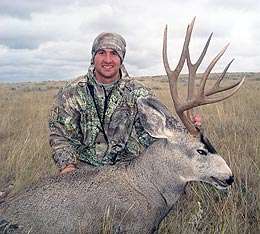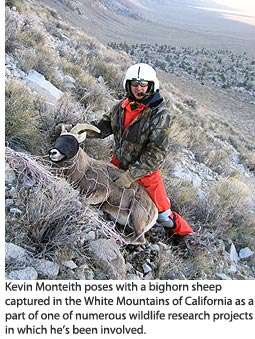Research shows slight decline in big game antler, horn size

(Phys.org)—A team of scientists led by a University of Wyoming researcher recently reported that the size of trophy horns and antlers of most species of North American big game has declined slightly over the past century, most likely as a result of intensive harvest of males.
Kevin Monteith, a postdoctoral research scientist with the Wyoming Cooperative Fish and Wildlife Research Unit, conducted the study along with colleagues from Idaho State University, the University of Montana and state wildlife agencies in California and Arizona. It was published this week in The Wildlife Society publication, "Wildlife Monographs."
In analyzing more than 22,000 records compiled by the Boone and Crockett Club over the past 108 years, the researchers found a small but statistically significant decline in trophy horn and antler size for 25 categories of North American big game animals, including mule deer, moose and elk. The researchers, all of whom are hunters, then set about to find reasons for the decline, which was, on average, 1.87 percent for trophy antlers and 0.68 percent for trophy horns from 1950 to 2008.

The most likely explanation, Monteith says, is that heavy harvest of males may have resulted in a gradual shift toward younger males—in other words, fewer males are reaching large trophy size before being taken by hunters. The study also looked at the possibility that removal of the biggest-antlered and -horned animals has depleted the gene pool over the years, but the research found limited support for that hypothesis.
"If there were truly a genetic effect over time, the decline may have been more substantial over 108 years, and we would not have expected increases in size among categories like that observed for pronghorn and musk ox," Monteith says. "In reality, the changes were small and consistent with a gradual push against the age structure due to harvest of males."
Through careful analyses, the biologists ruled out several other potential causes of the decline, including climate change, habitat alterations, and the "sociological effect" of increased interest among hunters in submitting trophies to the record book.
While some people may be alarmed at any decline in the size of trophy antlers and horns, Monteith says he sees the study's findings as evidence supporting the North American model of wildlife management—which focuses on harvest of males over females. The system has largely maintained healthy populations of animals with subtle changes in trophy size. At the same time, the study shows that if wildlife managers and the public are concerned about the slight decline in trophy size, "our results suggest there's likely a pretty quick and easy fix—a slight lessening of harvest pressure on males."
"We're not trying to tell wildlife managers what to do," he says. "We're simply reporting the results from an impressive data set while offering some considerations for effectively balancing competing interests in overall opportunity for harvest and opportunity to harvest trophy males."
More information: To see the study, go to onlinelibrary.wiley.com/doi/10.1002/wmon.1007/full
Provided by University of Wyoming

















